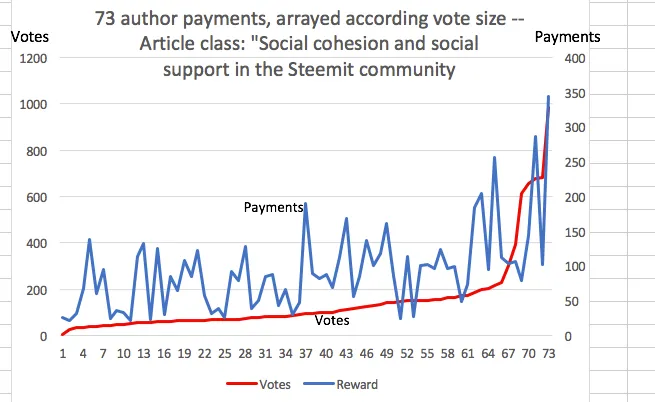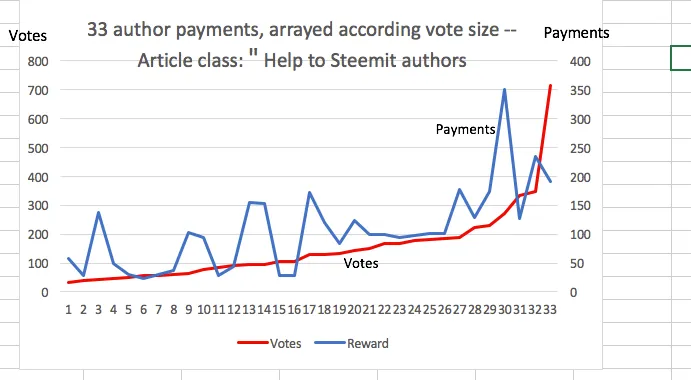When you upload a post, at what volume does the number of your up-votes begin to have a significant statistical association with the size of your author payment? The association tends to become strong primarily when the number of up-votes reaches well above 100. This is a finding from an examination that I made of 263 articles that appeared in the “Trending” menu late on September 30.
By studying these posts, I was able to group them into 53 classes, and the association just cited was tested within the classes that have a large number of articles. These classes are listed at the end of this post.
The two charts that follow feature two of the classes. The first is called “Social cohesion and social support in the Steemit community”, where there were 73 posts. I named the second-class “Help for Steemit authors”, and it contained 33 posts. Here is the first chart.

The numbers that you see in the horizontal axis are simply identification numbers for the articles. On the left vertical axis is the scale for number of up-votes, and on the right side is the scale for payments/rewards. I sorted the observations according to the size of the vote.
In the first chart, you see that the curve for the sorted number of votes (colour red) rises gently up to about 75 votes, and then it ‘screams’ upward. Basically, up to 75 up-votes the payments are ‘all over the map’. The good news, however, is that they have a base value close to 50 Steem Dollars (I guess).
Keep in mind, however, that these are Trending articles only. One of the interesting questions to raise is what was the total of non-trending articles over the time frame covered by the 73 items of the first chart. And if we collected a decent sample of those non-trending articles, where would the distribution of payments be concentrated?
There is another important caveat. Although it is instructive to isolate these two variables for examination, while looking at the articles one by one as we go from left to right, we should be holding constant other factors that help to explain the level of the author payment. If there is substantial interest in this post, I would try to do just this, which would make analysis much more sophisticated.
Coming back to the Trending articles in the first chart, we see that as the volume of up-votes starts to march upward very smartly near the right side of the curve, the central tendency of the payments also moves up quickly; but we continue to have a very wide range between the top and bottom values. Thus, we clearly need a more sophisticated analysis, where other explanatory variables are taken into account.
On the whole though, the chart is suggesting the message that if you are lucky enough to get your article into the Trending collection, you might get some big dollars (say $100-plus) at quite low volumes for the number of up-votes; but a good prediction that you will receive big dollars should include the assumption that your volume of up-votes is in the ‘100-plus area’, and you will be ‘in the sweet spot’ when your volume of up-votes approaches and passes the two-hundred level.
Let’s move to the second chart, where the posts fell into the class called “Help to Steemit authors”. Here we have only 33 posts.

The two curves follow each other more closely than is the case in the first chart. Generally, the rising trend of the sorted number of up-votes is associated with an ‘embedded’ upward sloping trend curve for the payments. Do note, however, that the wild swings in payments that we saw in the first chart seemed to be re-appearing as we move above 100 up-votes in the second chart.
The general message of the second chart seems to be broadly similar to that of the first, except at the curve for payments seems to be more sensitive to modest volume changes in the case of the second chart.
As an author, the key bottom lines for me are the following. First: when I am getting less than 20 up-votes, I am going to need some ‘special forces’ to get big dollars (i.e. in the $100-plus area). This, I'm afraid, is bad news for authors like me who tend to write on rather specialized subjects that have naturally small audiences (sigh)!
Second: I am going to need much more than the average number of up-votes for my type of article. This means that I should first establish what is the community of interest for my article, and then find out the typical distribution of up-votes for articles aimed at this community. Even if my article is lucky to find itself selected as a “Trending” post, I would need a lot more than the average number of up-votes for trending articles in my category, in order for the author payment to be substantial (at least relative to the time investment that I need to make in order to complete and upload the post).
Here is the set of 53 article classes that I derived by studying the said 263 Trending posts. I read far enough into each article to reach a reasonably considered judgment as to what its classification should be, near the end of the exercise when I was becoming quite tired (at which point I made the classification based on the content of the title).
(1) STEEMIT software improvement and extensions
(2) fictional story
(3) analysis of proposed STEEMIT protocol change
(4) promoting a STEEMIT-related event
(5) unclassified
(6) explanation or analysis of a computerized protocol
(7) privacy and security on the Internet
(8) social cohesion and the social support in the STEEMIT community
(9) sport events
(10) sport activities
(11) fashion
(12) lifestyle, personal aspirations and coping
(13) help for STEEMIT authors
(14) applications built on STEEM
(15) promoting non-financial aspects of personal well-being
(16) reflections on successes achieved and challenges met in life
(17) multilingual presentations
(18) volunteer work and giving for and to the needy
(19) promoting Internet-based personal services
(20) reporting external news and commentary about STEEMIT
(21) SMTs: tutorial, technical expositions, and promotion
(22) STEEMIT technical support
(23) guides to STEEMIT features and related resources
(24) promoting financial aspects of personal well-being
(25) STEEM's hardware infrastructure and associated software
(26) music
(27) cryptocurrency news
(28) Art: drawing, painting
(29) photography
(30) ethnic and race relations issue
(31) flowers and plants
(32) Steemit sub-communities
(33) travel and tourism
(34) poetry
(35) STEEM blockchain
(36) new members introducing themselves
(37) governments and crypto currency issues
(38) books
(39) gaming and gambling
(40) true adventure story
(41) curator function on STEEMIT
(42) statistical analysis of trading data and prediction models
(43) coin trading strategy and tactics
(44) Steem Power statistics
(45) contests
(46) Drama and film
(47) recipes and other food preparaton info.
(48) Algorthmic trading, robots, bots
(49) commentray on policices and politics
(50) Getting mainstream adoption for cryptocurrencies
(51) diet and nutrition
(52) managing personal finances
(53) cryptocurency exchanges.